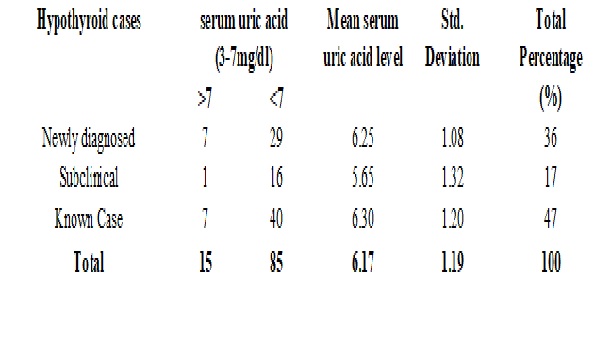A study of relationship of hyperuricemia in hypothyroid patients
Abstract
Introduction: Hypothyroidism is a common metabolic disorder in general population. The prevalence of primary hypothyroidism is 1:100, but it may be 5:100 if patients with subclinical hypothyroidism (normal T4, raised TSH) are included.The degree of severity ranges from mild and unrecognized hypothyroid states to striking myxedema. The thyroid dysfunction increases with age, especially in women.Uric acid has been found to be significantly elevated in primary hypothyroidism in many studies. In comparison to the prevalence reported in the general population, a significant increase of both Hyperuricemia and gout was found in the hypothyroid patients. In hypothyroidism, the hyperuricemia is secondary to a decreased renal plasma flow and impaired glomerular filtrationThis study was designed for evaluation of uric acid levels in hypothyroid patients which might be helpful for clinical management of hypothyroid patients with hyperuricemia.
Objective of Study: To find out any relationship between hyperuricemia in hypothyroidism patients.
Methods:In our study, out of 100 patients, only 15 were found to have increased serum uric acid levels and only 3 had increased urinary uric acid levels. Out of these 15, 9 were females and 6 males, or can be said out of 70 females in study; only 9 were having increased serum uric acid levels.
Results: In our study, the association between hypothyroid function and hyperuricemia seems to be week.No significant correlation was found betweenT3, T4 &TSH and serum uric acid.
Conclusion: The correlation between hypothyroidism and gout still remains a matter of debate and more extensive studies need to be done to come to a definitive conclusion.
Downloads
References
Mark P J Vanderpump,.Epidemiology of Thyroid Disease. British Medical Bulliten, 2011; 99; 39-51 DOI: https://doi.org/10.1093/bmb/ldr030.
Gagandeep Kaur Sidhu1, Rahima.R.Malek, Asha Khubchandani, Sohil.H.Mansuri, Miku.S.Patel, Ruhan.H. Oza.A Study of Serum Urea, Creatinine and Uric Acid Levels in Hypothyroid Patients. Int J Res Med.2016;5(2);115-118, pISSN:23202734.
Ueda H, Howson JM, Esposito L, et al. Association of the T-cell regulatory gene CTLA4 with susceptibility to autoimmune disease. Nature. 2003 May 29;423(6939):506-11. Epub 2003 Apr 30. DOI: https://doi.org/10.1038/nature01621.
Britto JM, Fenton AJ, Holloway WR, et al. Osteoblasts mediate thyroid hormone stimulation of osteoclastic bone resorption. Endocrinology. 1994 Jan;134(1):169-76. DOI: https://doi.org/10.1210/endo.134.1.8275930.
Surks MI. Response to position statement on subclinical thyroid dysfunction. EndocrPract. 2004 Nov-Dec;10(6):513-4. DOI: https://doi.org/10.4158/EP.10.6.513.
Fatourechi V, Klee GG, Grebe SK, et al. Effects of reducing the upper limit of normal TSH values. JAMA. 2003 Dec 24;290(24):3195-6. DOI: https://doi.org/10.1001/jama.290.24.3195-a.
Hamilton, T.E., et al., Thyrotropin levels in a population with no clinical, autoantibody, or ultrasonographic evidence of thyroid disease: implications for the diagnosis of subclinical hypothyroidism. J Clin Endocrinol Metab. 2008 Apr;93(4):1224-30.doi: https://doi.org/10.1210/jc.2006-2300. Epub2008 Jan29.
Giordano N, Santacroce C, Mattii G, et al. Hyperuricemia and gout in thyroid endocrine disorders. Clin Exp Rheumatol. 2001 Nov-Dec;19(6):661-5.
Saini V, Yadav A, Arora MK, et al. Correlation of creatinine with TSH levels in overt hypothyroidism - a requirement for monitoring of renal function in hypothyroid patients? Clin Biochem. 2012 Feb;45(3):212-4. doi: https://doi.org/10.1016/j.clinbiochem.2011.10.012. Epub 2011 Oct 28.
Domrongkitchaiporn S, Sritara P, Kitiyakara C, et al. Risk factors for development of decreased kidney function in a southeast Asian population: a 12-year cohort study. J Am Soc Nephrol. 2005 Mar;16(3):791-9. Epub 2005 Jan 26. DOI: https://doi.org/10.1681/ASN.2004030208.
Johnson GC, Esposito L, Barratt BJ, et al. Haplotype tagging for the identification of common disease genes. Nat Genet. 2001 Oct;29(2):233-7.



 OAI - Open Archives Initiative
OAI - Open Archives Initiative


